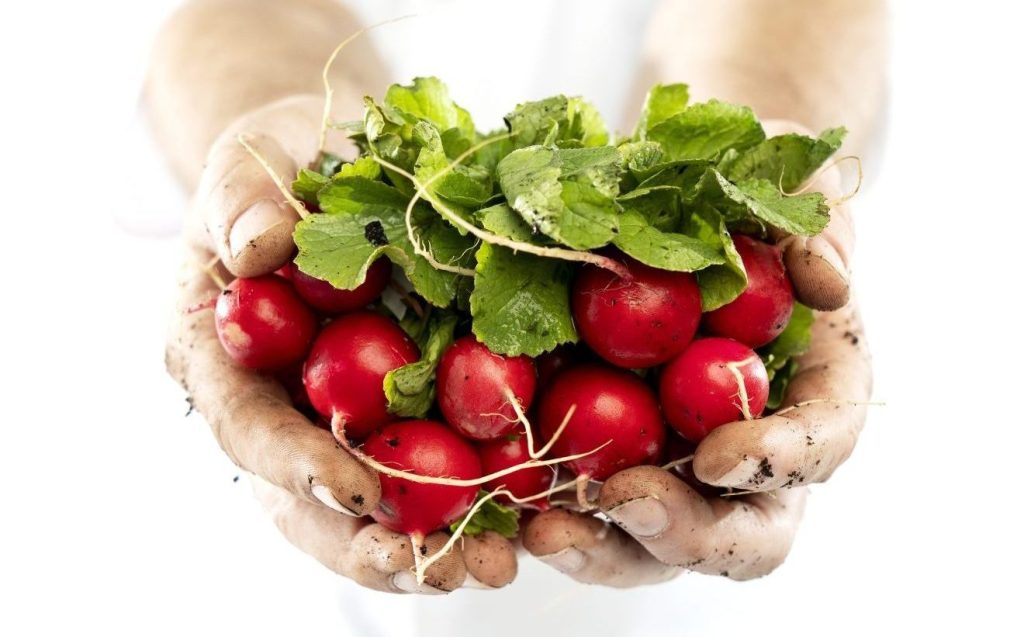Photos by L.G. Patterson
One of the best things about late spring/ early summer is the abundance of fresh seasonal produce. But picking — no pun intended — the top of the crop requires some savvy. We asked several local resources for tips on how to select the best early season bounty or successfully cultivate your own.
OUR PRODUCE PRO PANEL
Tammy and Greg Sellmeyer, owners of Sellmeyer Farm
Steve and Caroline Andriano, owners of Blue Shepherd Farm
Lexi Linsenman, development manager with the Columbia Center for Urban Agriculture (CCUA)
Mallary Lieber, CCUA garden pro associate
Heidi Hinneman, AmeriCorp VISTA volunteer coordinator and CCUA apprentice
Don Ginsburg, Columbia garden enthusiast
The Last Straw(berry)
More like the first. Tammy and Greg Sellmeyer, owners of Sellmeyer Farm in Fulton, have been growing early strawber- ries for 20 years. The two grow them as annuals, as opposed to perennials, which means they put in 3,000 plants annually — just the two of them, by themselves. The Sellmeyers raise Chandlers, a variety intended for hoop house production.
By using their hoop house, the Sellmeyers can get a head start on growing. “In years past, we’ve gotten strawberries as early as mid-to-late April,” Tammy says.
Growing earlier and in a hoop house helps to prevent their berries from being ravaged by spotted wing drosophila, a serious fruit fly pest that loves soft fruit and berries. Tammy says when you grow strawberries, you’re going to get the most and biggest berries your first year. “Every year after that, the amount and size goes down.” She says the berries also get smaller throughout the season. Many home growers keep the same plants and, when those put down runners (so called because they are horizontal stems that run above the ground and produce new ‘baby’ clone plants at their ends), they’re allowed to run into the aisle between the rows. The grower will then mow off the center of the old row, essentially yielding them new plants every year.
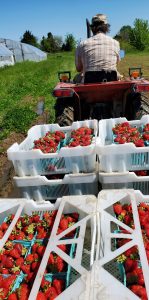
Pro Picking Tips (Mallary Lieber)
“For maximum sweetness and flavor, pick berries a day or two after they are fully red. Berries picked before they are completely red will eventually turn red, but they will not sweeten.”
Slightly unripe fruit can be used for making jam. Under favorable conditions, expect a total yield of about one quart of fruit per foot of matted row. Immediately remove berries that do not ripen because they harbor diseases and attract insects.
Storage Smarts (Mallary Lieber & Tammy Sellmeyer)
Tammy recommends slicing fresh strawberries after purchasing and placing them in a covered container in the fridge. “Don’t wash them until you’re ready to eat them. They’ll last longer. They’re ripe, so when they start molding, it’s usually on the bottom. Slicing makes the berries less heavy and likely to smush, which can contribute to mold.”
Mallary’s tip is to freeze sliced strawberries with sugar to eat months later, noting it’s “a great way to recall spring during the cold winter.”
Home Growing Hints (Tammy Sellmeyer)
Tammy says that in the first two years of your strawberry plants’ lives, any runners should be cut off from where they originate, to force the plant to focus all of its efforts and energy on fruit production.
A Case of the Blues
At least a few pints! Fresh blueberries are the bumper crop at Steve and Caroline Andriano’s Blue Shepherd Farm in Rocheport. The couple also raise mountain sheep, hence their farm’s name.

The Andrianos first planted blueberries in 2012 and Steve says they have about 800 plants. He likens blueberry plants to his farm’s mountain sheep: “Both are essentially dependent on you as soon as you get them. All you’re doing is keep them alive.” Not intending to be morbid, Steve explains: “By the time there’s a problem with a blueberry plant, it’s too late. By the time you know there’s a problem with sheep, it’s too late. All you’re doing is staying out in front of them, keeping them healthy and being organic.” He acknowledges being organic makes it a little harder but says “you just fight problems with what’s available organically.”
Blueberries are a little high maintenance. “It’s a real needy plant and wants a certain soil moisture content. Can’t be too wet, can’t be too dry — they want a certain amount of organic content,” Steve says. “They definitely want pH at a certain level that’s not natural for here. They need a lot of nutrients because they’re like little factories. You’d say, ‘Why? They just make blueberries.’ Well, blueberries are made up of calcium, magnesium, copper, nitric acid, potassium and phosphorus. The plant just doesn’t magically generate phosphorus, it converts it. So you’ve got to figure out how much phosphorus do you need?”
The Andrianos offer “u-picking” by appointment through their website for about six weeks, usually starting the first week of June. They say, “Mother Nature decides it. So it could be the second week. And then it usually goes to the second week of July, at the very latest.”
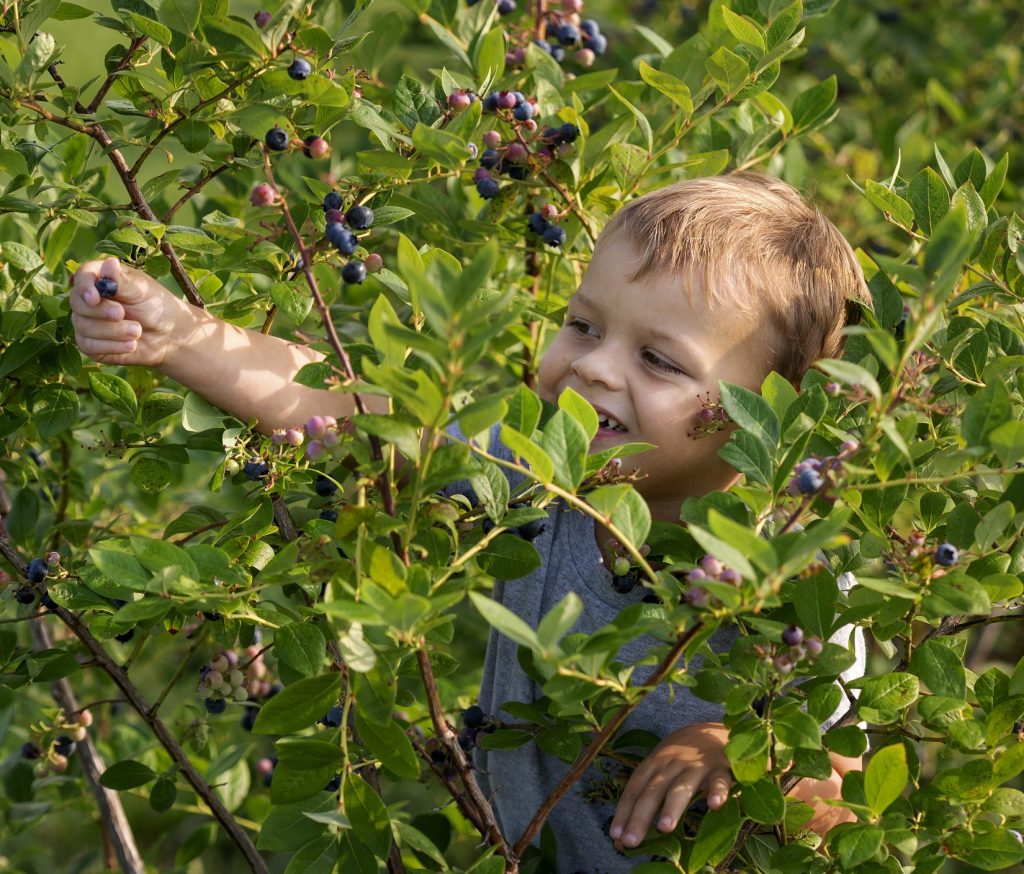
Pro Picking Tips (Steve Andriano)
“Look for larger, plump, firm berries.”
“Don’t wash berries until right before you use them. When you wash a berry, you disturb the fibers on the outside and it starts breaking down and it’ll just deteriorate more quickly if you wash it.”
Storage Smarts (Caroline Andriano & Mallary Lieber)
Mallary suggests keeping berries in very shallow containers or very small jars. “If you have them more than a couple layers thick, the weight of the other berries is going to smush the ones underneath.”
Caroline’s method is to put them on a cookie sheet and place it in the freezer. “When they’re solid, we just bag them in zip bags and put those in the freezer.”
Home Growing Hints (Mallary Lieber)
The MU Extension Center says blueberry flowers and fruit grow from buds on one-year-old wood. A certain amount of new growth each year is essential for sustained production as they grow from buds of the previous growing season.
You should also remove flower buds for the first two growing seasons “to allow the plant to become established and develop into a more vigorous plant.”
The third growing season gets tricky and production should be based on size and vigor of the plants, according to the MU Extension Center. “Vigorous three-year-old bushes can be allowed to produce a small crop, while most if not all flower buds from weak third-year plants should be removed.”
Mallary advises to allow berries to get to full maturity, if it can be helped.
Mallary: “If left on the bush after ripening, blueberries do not spoil for at least one week. Their flavor and sweetness continue to increase. Unfortunately, this makes the berries very attractive to birds.”
No Aspara-guessing
When it comes to asparagus tips — as in tips on how to select or grow your own crop, CCUA Garden Pro Associate Mallary Lieber can help. She says there’s a huge market for fresh, locally grown asparagus because it’s so different from what you buy in the store. And since asparagus reseeds itself, it’s fairly easy to grow.
One of the earliest asparagus varieties is Purple Haze. Purple asparagus is a bit nuttier and sweeter than green or white because it has about 20% more sugar in its stalks. Although the stalks are purple on the outside, inside they’re the same color as a green spear. Many people enjoy purple asparagus raw. But as pretty as it is raw, once cooked it turns green.
Mallary recommends prioritizing purple (and red) fruits and vegetables in your diet. “Purple (and red) fruits and vegetables aren’t just beautiful. They are full of antioxidants called anthocyanins. Eating more purple and red will literally improve your health at a cellular level. Antioxidants protect cells from damage, are correlated with heart health and might help reduce the risk of several cancers.”
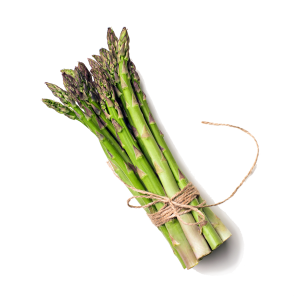
Pro Picking Tips (Columbia Center for Urban Agriculture)
Quality growing conditions create tastier asparagus and the spears can be thick or thin. Look for uniform size when shopping at the market for even cooking.
The MU Extension Center says stalks should be firm and not at all limp, and the tips should still be tight.
“Look for where they were grown. Local veggies are always better! If you think about it, people aren’t very fresh after traveling thousands of miles either, and we are still alive. Veggies that can make the journey and still look good aren’t bred for flavor.” – Heidi Allemann
Storage Smarts (Columbia Center for Urban Agriculture)
Store asparagus on ice. Wrap with a damp cloth then refrigerate or put in a glass jar with an inch of water in a cool spot. Asparagus should be eaten two to five days after picking.
Home Growing Hints (Mallary Lieber)
It’s best to start asparagus from crowns. The first spring, a year after planting, do not harvest any spears. Allow them to become ferns and build the strength of the crowns.
The second spring after planting, if the plants were strong and healthy during the previous growing season, only pick asparagus for two weeks. After that, allow the spears to develop into ferns.
In the following years, harvest the spears when they’re 6-8 inches tall, up to July 1. Either snap or cut them off at ground level.
Wait as long as possible to cut back the ferns in the fall. If you cut them back too soon, it will negatively affect the next
year’s crop.
Not a Car(e)rot in the World
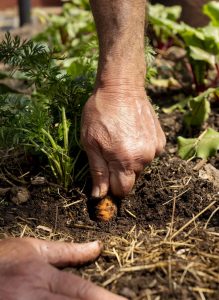
What’s up, doc? Actually, what’s down. Carrots are a root vegetable, as well as a cool-season one. When daily high temperatures exceed 80 degrees Fahrenheit, carrot color and taste will diminish, rendering them bit- ter and woody, according to the MU Extension Center.
Carrots come in a variety of colors, the classic beta carotene boasting orange, as well as yellow, red, purple and white. All colors supply valuable nutrients, though what those nutrients are will vary depending on the carrot color.
They need a loose, friable (easily crumbled) soil to develop a good shape. ‘Forking,’ when a carrot develops multiple prongs, is caused by anything that impedes root growth. This includes roundworms, stones or heavy, compacted soil.
Another common carrot concern cited by MU Extension is planting carrot seeds too deep. They should be planted no deeper than 1⁄4-inch. It takes about three weeks for carrot seeds to germinate and emerge from the soil, so you shouldn’t be concerned as long as you didn’t plant them too deep.
Pro Picking Tips (Mallary Lieber)
Mallary advises choosing produce with some of the greens still attached. “If some of the greens are still present you know the crop was harvested recently and is, of course, more nutrient dense. Carrots that travel far and are stored for prolonged periods of time will have all of the greens removed, as that is the part that goes bad first.”
Storage Smarts (Mallary Lieber)
Mallary says to wrap up carrots and other root vegetables in a moist towel before refrigerating, “basically to trick them into thinking they are still in the ground.”
Home Growing Hints
According to the MU Extension Center, carrot roots can get sunburned, resulting in bitter, green tops. Help prevent this by hilling soil around the shoulders of the carrot roots.
Getting the (Ra)dish
Columbia garden enthusiast Don Ginsburg has been growing radishes for 20 years. “I always start from seed,” he says. But he experiments with many different varieties including French Breakfast, China Rose and White Icicle. With so many different types, there’s quite the variety in terms of the resulting radishes. Red is the color most closely associated with radishes, but they can range from red and pink, to white and every hue in between. Green and black radishes are even native to a few countries. That’s not all that can differ. “They come in various shapes and sizes from round to oval to carrot-shaped,” Don says.

Radishes are rich in antioxidants and minerals like calcium and potassium; nutrients that help lower high blood pressure and reduce your risks for heart disease.
Perfect for gardeners who are impatient or room-restricted, radishes are quick to develop, don’t take up a lot of space and can be grown in a garden bed or container, such as a grow bag.
Of course, radishes can be eaten raw, as is commonly done, but are quite deli- cious grilled and have an entirely different texture and flavor, Don says. In addition, their greens can be enjoyed in salads and used to make pesto. Plus, the small seedlings that are thinned during the early growing stages can be eaten in salads.
Pro Picking Tips (Don Ginsburg)
Don’s advice: “When buying at farmer’s market or grocery, look for the greens to be bright green, fresh and perky. You don’t want any browning or wilting. The radishes should be hard, firm and crunchy.”
Storage Smarts (Don Ginsburg)
Store them in a plastic container in the refrigerator and they can store well for two weeks or more, Don says.
Home Growing Hints (Don Ginsburg)
Seeds can be planted in late winter, early spring or even fall. To give them room to mature, thin them about 2 to 3 inches apart.
Plant every 10 days to two weeks to have a continuous crop.
Move the dirt to determine how large and ready a radish is. Remember, younger equals more tender. If they grow too long, they will begin cracking and become woody.

